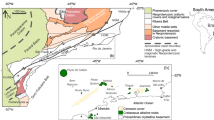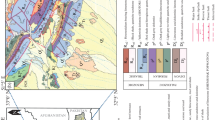Abstract
We report here for the first time geochemical, mineralogical and stable carbon and oxygen isotopic data on the crystalline basement rocks of the 1993 Killari earthquake region of Maharashtra (India), which is covered by a thick suite of Deccan volcanics. Our results revealed the hitherto unknown amphibolite–granulite nature of the 2.5 Ga basement, which contains 2.00–2.28 wt% of CO2. The stable carbon (δ13C) and oxygen (δ18O) isotopic measurements on carbonates separated from two basement samples KIL-13 (440.5 m depth) and KIL-20 (499.6 m depth) collected from the KLR-1 borehole drilled in the epicentral region showed the respective values of −6.23 and −6.22‰ versus PDB for δ13C and 7.94 and 8.11‰ versus SMOW for δ18O. The samples plot in the primary igneous carbonatite field, indicating the mantle origin of the carbonates, derived through the process of mantle metasomatism from the deep mantle carbon reservoir. This would suggest large-scale crust-mantle thermal fluid interaction beneath the Killari seismogenic region, which is characterized by massive upwarping of the high-velocity mafic crust and retrograde metamorphism.








Similar content being viewed by others
References
Ahmad SM, Babu GA, Padmakumari VM, Raza W (2008) Surface and deep water changes in the northeast Indian Ocean during the last 60 ka inferred from carbon and oxygen isotopes of planktonic and benthic foraminifera. Palaeogeogr Palaeoclimatol Palaeoecol 262:182–188
Balram V, Rao TG (2003) Rapid determination of REEs and other trace elements in geological samples by microwave acid digestion and ICP-MS. Atomic Spectrosc 24:206–212
Courtillot V, Feraud G, Maluski H, Vandamme D, Moreau MG, Besse J (1988) Deccan flood basalts and the Cretaceous/Tertiary boundary. Nature 333:843–846
Desai AG, Markwick A, Vaselli O, Downess H (2004) Granulite and pyroxenite xenoliths from the Deccan Trap: insight into the nature and composition of the lower lithosphere beneath cratonic India. Lithos 78:263–290
Dingwell DB (1998) The glass transition in hydrous granitic melts. Phys Earth Planet Int 107:1–8
Duncan RA, Pyle DG (1988) Rapid eruption of the Deccan flood basalts at the Cretaceous/Tertiary boundary. Nature 333:841–843
Eremenko NA, Negi BS, Kasianov MV et al (1969) Tectonic map of India. Bull Oil Nat Gas Comm India 6:1–11
Gupta HK, Dwivedi KK (1996) Drilling at Latur earthquake region exposes a peninsular gneiss basement. J Geol Soc India 47:129–131
Gupta HK, Srinivasan R, Rao RUM, Rao GV et al (2003) Borehole investigations in the surface rupture zone of the 1993 Latur SCR earthquake, Maharashtra, India: overview of results. Mem Geol Soc India 54:1–22
Halama R, Vennemann T, Siebel W, Markl G (2005) The gronnedal-ika carbonatite—syenite complex, South Greenland: carbonatite formation by liquid immiscibility. J Petrol 46:191–217
Henry DJ (1988) CL-rich minerals in Archean granulite facies ironstones from the Beartooth Mountains, Montana, USA: implications for fluids involved in granulite metamorphism. J Geol Soc India 31:43–45
Hollister LS (1988) CO2-rich fluid intrusions in greenschists, migmatites, granulites and hydrated granulites. J Geol Soc India 31:46–47
Jayaraman KS (2007) India’s carbon dioxide Trap. Nature 445:350
Jiang SY, Wang R, Xu X, Zhao K (2005) Mobility of high field strength elements (HFSE) in magmatic-, metamorphic-, and submarine-hydrothermal systems. Phys Chem Earth 30:1020–1029
Keller J, Hoefs J (1995) Stable isotope characteristics of recent natrocarbonatites from Oldoinyo Lengai. In: Bell K, Keller J (eds) Carbonatite volcanism: Oldoinyo Lengai and petrogenesis of natrocarbonatites. IAVCEI proceedings of volcanology IAVCEI, pp 113–123
Krishna AK, Govil PK (2007) Soil contamination due to heavy metals from an industrial area of Surat, Gujarat, Western India. Environ Monit Assess 124:263–275. doi:10.1007/s10661-006-9224-7
Kumar P, Yuan X, Ravi Kumar M, Kind R, Li X, Chadha RK (2007) The rapid drift of Indian tectonic plate. Nature 449:894–897
Le Bas MJ, Le Maitre RW, Streckeisen A, Zanettin B (1986) A chemical classification of volcanic rocks based on the total alkali-silica diagram. J Petrol 27:745–750
Mandal P, Pandey OP (2010) Relocation of aftershocks of the 2001 Bhuj earthquake: a new insight into seismotectonics of the Kachchh seismic zone, Gujarat, India. J Geod 49:254–260
Mandal P, Pandey OP (2011) Seismogenesis of the lower crustal intraplat earthquakes occurring in Kachchh, Gujarat, India. J Asian Earth Sci 42:479–491
Marki G, Bucher K (1998) Composition of fluids in the lower crust inferred from metamorphic salts in lower crustal rocks. Nature 391:781–783
Middelmost EAK (1989) Iron oxidation ratios, norms and the classification of volcanic rocks. Chem Geol 77:19–26
Middlemost EAK (1985) Magmas and magmatic rocks. Longman, London, p 266
Newton RC (1988) Nature and origin of fluids in granulite facies metamorphism. J Geol Soc India 31:103–105
Newton RC, Smith JV, Windley BF (1980) Carbonic metamorphism, granulites, and crustal growth. Nature 288:45–50
Pandarinath K, Dulski P, Torres-Alvarado IS, Verma SP (2008) Elemental mobility during the hydrothermal alteration of rhyolitic rocks of the Los Azufres geothermal field, Mexico. Geothermics 37(1):53–72
Pande K, Venkatesan TR, Gopalan K, Krishnamurthy P, Macdougall JD (1988) 40Ar–39Ar ages of alkali basalts from Kutch, Deccan volcanic province. India Geol Soc Ind Mem 10:145–150
Pandey OP, Agrawal PK (1999) Lithospheric mantle deformation beneath Indian cratons. J Geol 107:683–692
Pandey OP, Chandrakala K, Parthasarathy G, Reddy PR, Koti Reddy G (2009a) Upwarped high velocity mafic crust, subsurface tectonics and causes of intraplate Latur-Killari (M 6.2) and Koyna (M 6.3) earthquakes, India—a comparative study. J Asian Earth Sci 34:781–795
Pandey OP, Chandrakala K, Reddy PR, Koti Reddy G (2009b) Structure, tectonics and thermal state of the Lithosphere beneath intraplate seismic region of Latur, central India : an appraisal. J Geol Soc India 73:457–468
Parthasarathy G (2006) Zeolite zonation and amygdaloidal minerals from the Killari borehole of Deccan traps, Maharashtra, India. J Appl Geochem 8:546–557
Parthasarathy G, Kunwar AC, Srinivasan R (2001) Occurrence of moganite-rich chalcedony in Deccan flood basalts, Killari, Maharashtra, India. Eur J Miner 13:127–134
Parthasarathy G, Chetty TRK, Haggerty SE (2002) Thermal stability and spectroscopic studies of zemkorite: a carbonate from the Venkatampalle kimberlite of southern India. Am Mineral 87:1384–1389
Parthasarathy G, Choudary BM, Sreedhar B, Kunwar AC, Srinivasan R (2003a) Ferrous saponite from Deccan Trap, India, and its application in adsorption and reduction of hexavalent chromium. Am Mineral 88:1983–1988
Parthasarathy G, Choudary BM, Srinivasan R, Kunwar AC (2003b) Reduction of hexavalent chromium by natural iron-rich saponite. Geochim Cosmochim Acta 67:376
Parthasarathy G, Choudary BM, Sreedhar B, Kunwar AC (2007) Environmental mineralogy: spectroscopic studies on ferrous saponite and reduction of hexavalent chromium. Nat Hazards 40:647–652
Ravi Shankar (1995) Fragmented Indian shield and recent earthquake. Geol Surv India Spec Publ 27:41–48
Reid DL, Cooper AF (1992) Oxygen and carbon isotope patterns in the Dicker Willem carbonatite complex, southern Namibia. Chem Geol 94:293–305
Santos EV, Clayton RA (1995) Variations of oxygen and carbon isotopes in carbonatites: a study of Brazilion alkaline complexes. Geochim Cosmochim Acta 59:1339–1352
Schleicher H, Kramm U, Pernicka E, Schidlowski M, Schmidt F, Subramanian V, Todt W, Viladkar SG (1998) Enriched subcontinental upper mantle beneath southern India: evidence from Pb, Nd, Sr, and C–O isotopic studies on Tamil Nadu carbonatites. J Petrol 39:1765–1785
Sen G, Bizimis M, Das R, Paul DK, Ray A, Biswas B (2009) Deccan plume, lithosphere rifting, and volcanism in Kutch, India. Earth Planet Sci Lett 277:101–111
Singh AP, Mall DM (1998) Crustal accretion beneath the Koyna coastal region (India) and late Cretaceous geodynamics. Tectonophysics 290:285–297
Sun SS, McDonough WF (1989) Chemical and isotopic systematic of oceanic basalts: implications for mantle composition and process. In: Saunders AD, Norrey MJ (eds) Magmatism in the ocean basins. Geol Society of London Special Publ 42:313–345
Taylor HP Jr, Frechen J, Degens ET (1967) Oxygen and carbon isotope studies of carbonatites from the Laacher sea district, west Germany and the Alno district, Sweden. Geochim Cosmochim Acta 31:407–480
Torres-Alvarado IS, Pandarinath K, Verma SP, Dulski P (2007) Mineralogical and geochemical effects due to hydrothermal alteration in the Los Azufres geothermal field, Mexico. Revista Mexicana de Ciencias Geologicas 24(1):15–24
Verma SP, Torres-Alvarado IS, Sotelo-Rodriguez ZT (2002) SINCLAS: standard igneous norm and volcanic rock classification system. Comput Geosci 28:711–715
Verma SP, Torres-Alvarado IS, Velasco-Tapia F (2003) A revised CIPW norm. Schweiz Mineral Petrogr Mitt 83(2):197–216
Viladkar SG, Schidlowski M (2000) Carbon and oxygen isotope geochemistry of the Amba Donger carbonatite complex, Gujrat, India. Gond Res 3:415–424
Zacharaiah JK (1998) Pb–Pb age, Nd and Sr isotopic data on the basement rock to Deccan traps at Killari earthquake site, Latur district, Maharashtra. Abstract, AGU Chapman conference on “stable continental region earthquakes”, Hyderabad, Jan 25–29, p 30
Acknowledgments
We are most grateful to Prof. Surendra P. Verma, centro de Investigacion en Energia, Universidad Nacional Autónoma de Mexico, for his valuable comments and providing more useful references in improving the manuscript. We are extremely grateful to Dr Kasturi Chakravarty of Gelogical Survey of India (Hyderabad) for looking at thin sections and useful discussions. We also thank Drs. Kesav Krishna, S. S. Sawant and M. V. M. S. Rao for their help in data acquisition and K. S. V. Subramanyam, Parijat Roy and U. Raval for useful discussions. We are also grateful to Director, Indian Institute of Chemical Technology, Hyderabad for their encouragement and providing analytical support. Dr. G. Koti Reddy provided the basement samples from the Killari borehole. To him, we extend our sincere thanks. Without his support, this study would not have been possible. The permission accorded to publish this paper by Director NGRI is also gratefully acknowledged.
Author information
Authors and Affiliations
Corresponding author
Rights and permissions
About this article
Cite this article
Tripathi, P., Parthasarathy, G., Ahmad, S.M. et al. Mantle-derived fluids in the basement of the Deccan Trap: evidence from stable carbon and oxygen isotopes of carbonates from the Killari borehole basement, Maharashtra, India. Int J Earth Sci (Geol Rundsch) 101, 1385–1395 (2012). https://doi.org/10.1007/s00531-011-0723-6
Received:
Accepted:
Published:
Issue Date:
DOI: https://doi.org/10.1007/s00531-011-0723-6




